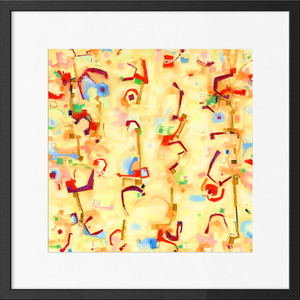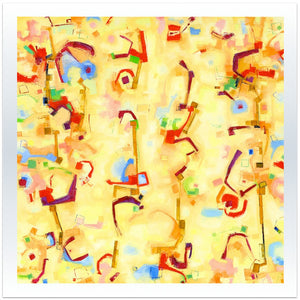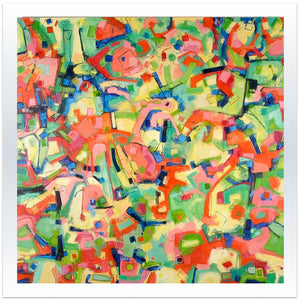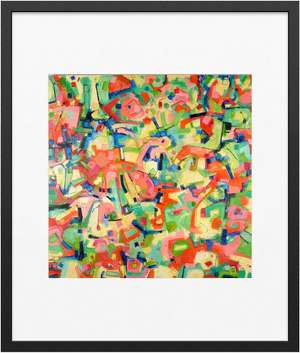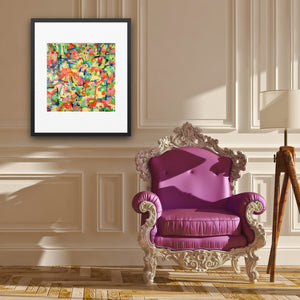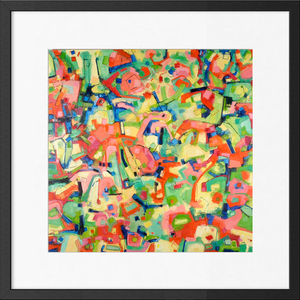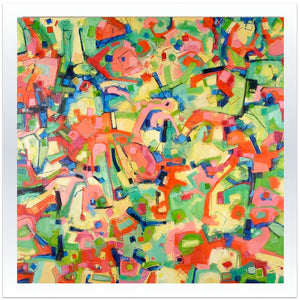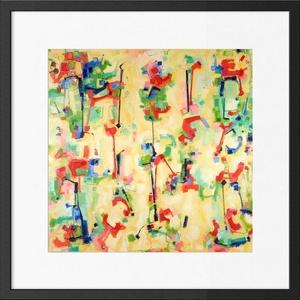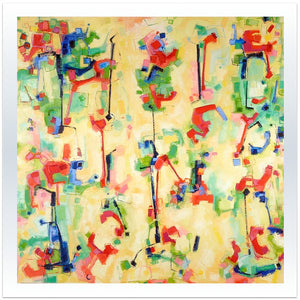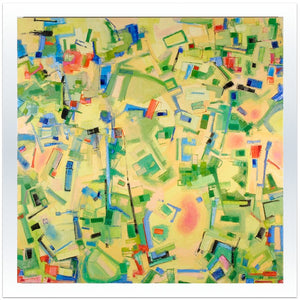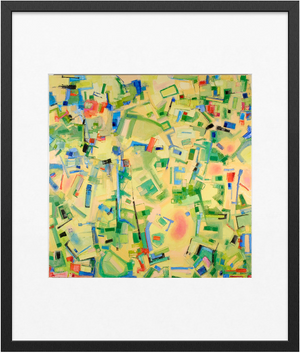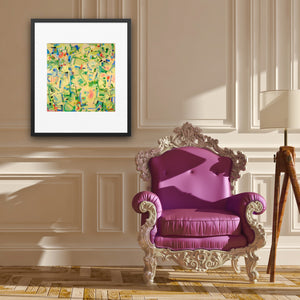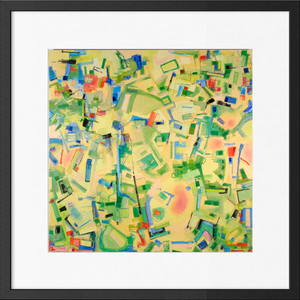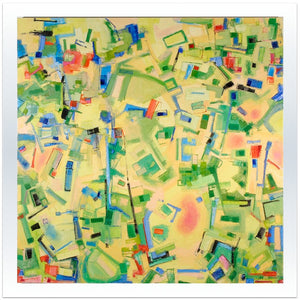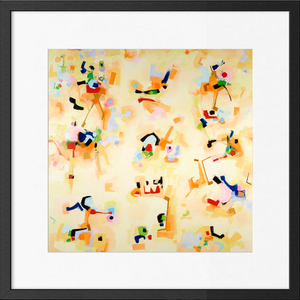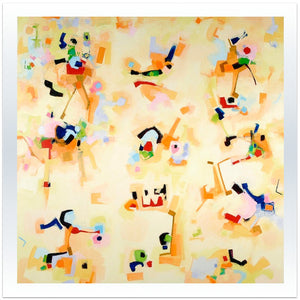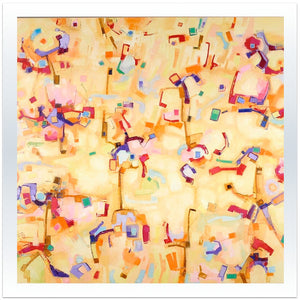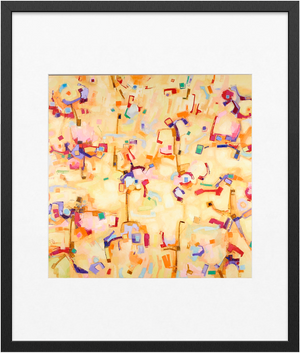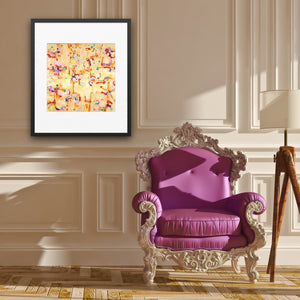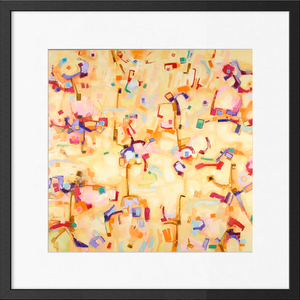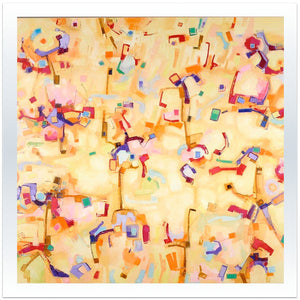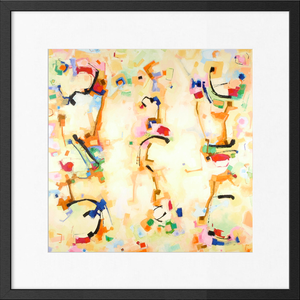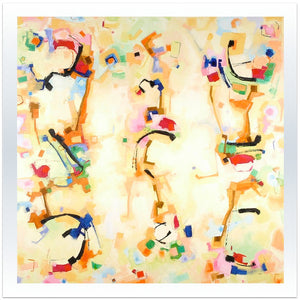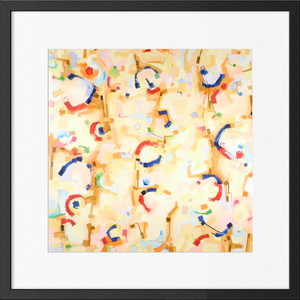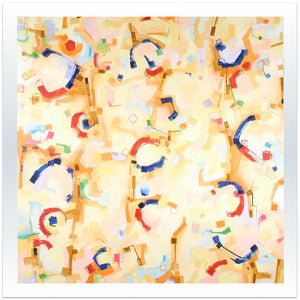Untitled 15D - Giclée Print
$ 43.50
-
A giclée reproduction of Untitled 15D, 2000 by Osvaldo Mariscotti.
Giclées are prints generated from digital scanning. They are extremely accurate in their interpretations of original works to the extent that they can capture the most subtle nuances of color and texture. The process results in prints that are water, fade and scratch resistant.
The Pseudo-figurative period (1996-2000) is characterized by vibrant paintings that resemble works from the Red Period; however, incorporating ideas from the later Geometric Period. The canvas is completely covered by color, with darker shapes, usually in black or blue, spread uniformly across the work. We observe the first efforts at dividing the canvas in clearly demarcated sections, something that will become a personal symbol for the artist in later periods. The artist introduces for the first time the concept of "change" and "progression", establishing milestones for later work.
-
- Marked with the artist's signature stamp.
- Each edition is printed on 100% rag Hahnemühle William Turner paper.
-
- Free shipping on $50+ orders (FAQs: View Here)
- Unframed: ready to ship in 1-3 business days.
- Framed: ready to ship in 1-2 weeks.
Untitled 21A
$ 75.00
-
A giclée reproduction of Untitled 21A, 2001 by Osvaldo Mariscotti.
Giclées are prints generated from digital scanning. They are extremely accurate in their interpretations of original works to the extent that they can capture the most subtle nuances of color and texture. The process results in prints that are water, fade and scratch resistant.
-
- Each edition is printed on 100% rag Hahnemühle William Turner paper.
- All prints are manually numbered, signed and shipped with a certificate of authenticity.
-
- Of 50: 20 x 20 inches (50.8 x 50.8 cm); Outer dimensions (framed): 28.3 x 25.9 inches (71.9 x 65.8 cm)
- Of 25: 15 x 15 inches (38.1 x 38.1 cm); Outer dimensions (framed): 22.6 x 20.5 inches (57.4 x 52.1 cm)
- Of 25: 10 x 10 inches (25.4 x 25.4 cm); Outer dimensions (framed): 15.5 x 15.5 inches (39.4 x 39.4 cm)
-
- Free shipping on all UK orders.
- £4.99 shipping on all international orders.
- Unframed: ready to ship in 3-5 business days.
- Framed: ready to ship in 1-2 weeks.
Untitled 21A - Giclée Print
$ 43.50
-
A giclée reproduction of Untitled 21A, 2000 by Osvaldo Mariscotti.
Giclées are prints generated from digital scanning. They are extremely accurate in their interpretations of original works to the extent that they can capture the most subtle nuances of color and texture. The process results in prints that are water, fade and scratch resistant.
The Pseudo-figurative period (1996-2000) is characterized by vibrant paintings that resemble works from the Red Period; however, incorporating ideas from the later Geometric Period. The canvas is completely covered by color, with darker shapes, usually in black or blue, spread uniformly across the work. We observe the first efforts at dividing the canvas in clearly demarcated sections, something that will become a personal symbol for the artist in later periods. The artist introduces for the first time the concept of "change" and "progression", establishing milestones for later work.
-
- Marked with the artist's signature stamp.
- Each edition is printed on 100% rag Hahnemühle William Turner paper.
-
- Free shipping on $50+ orders (FAQs: View Here)
- Unframed: ready to ship in 1-3 business days.
- Framed: ready to ship in 1-2 weeks.
Untitled 23C - Giclée Print
$ 43.50
-
A giclée reproduction of Untitled 23C, 2000 by Osvaldo Mariscotti.
Giclées are prints generated from digital scanning. They are extremely accurate in their interpretations of original works to the extent that they can capture the most subtle nuances of color and texture. The process results in prints that are water, fade and scratch resistant.
The Pseudo-figurative period (1996-2000) is characterized by vibrant paintings that resemble works from the Red Period; however, incorporating ideas from the later Geometric Period. The canvas is completely covered by color, with darker shapes, usually in black or blue, spread uniformly across the work. We observe the first efforts at dividing the canvas in clearly demarcated sections, something that will become a personal symbol for the artist in later periods. The artist introduces for the first time the concept of "change" and "progression", establishing milestones for later work.
-
- Marked with the artist's signature stamp.
- Each edition is printed on 100% rag Hahnemühle William Turner paper.
-
- Free shipping on $50+ orders (FAQs: View Here)
- Unframed: ready to ship in 1-3 business days.
- Framed: ready to ship in 1-2 weeks.
Untitled 30B
$ 75.00
-
A giclée reproduction of Untitled 30B, 2001 by Osvaldo Mariscotti.
Giclées are prints generated from digital scanning. They are extremely accurate in their interpretations of original works to the extent that they can capture the most subtle nuances of color and texture. The process results in prints that are water, fade and scratch resistant.
-
- Each edition is printed on 100% rag Hahnemühle William Turner paper.
- All prints are manually numbered, signed and shipped with a certificate of authenticity.
-
- Of 50: 20 x 20 inches (50.8 x 50.8 cm); Outer dimensions (framed): 28.3 x 25.9 inches (71.9 x 65.8 cm)
- Of 25: 15 x 15 inches (38.1 x 38.1 cm); Outer dimensions (framed): 22.6 x 20.5 inches (57.4 x 52.1 cm)
- Of 25: 10 x 10 inches (25.4 x 25.4 cm); Outer dimensions (framed): 15.5 x 15.5 inches (39.4 x 39.4 cm)
-
- Free shipping on all UK orders.
- £4.99 shipping on all international orders.
- Unframed: ready to ship in 3-5 business days.
- Framed: ready to ship in 1-2 weeks.
Untitled 30B - Giclée Print
$ 43.50
-
A giclée reproduction of Untitled 30B, 1999 by Osvaldo Mariscotti.
Giclées are prints generated from digital scanning. They are extremely accurate in their interpretations of original works to the extent that they can capture the most subtle nuances of color and texture. The process results in prints that are water, fade and scratch resistant.
The Pseudo-figurative period (1996-2000) is characterized by vibrant paintings that resemble works from the Red Period; however, incorporating ideas from the later Geometric Period. The canvas is completely covered by color, with darker shapes, usually in black or blue, spread uniformly across the work. We observe the first efforts at dividing the canvas in clearly demarcated sections, something that will become a personal symbol for the artist in later periods. The artist introduces for the first time the concept of "change" and "progression", establishing milestones for later work.
-
- Marked with the artist's signature stamp.
- Each edition is printed on 100% rag Hahnemühle William Turner paper.
-
- Free shipping on $50+ orders (FAQs: View Here)
- Unframed: ready to ship in 1-3 business days.
- Framed: ready to ship in 1-2 weeks.
Untitled 40G - Giclée Print
$ 43.50
-
A giclée reproduction of Untitled 40G, 2000 by Osvaldo Mariscotti.
Giclées are prints generated from digital scanning. They are extremely accurate in their interpretations of original works to the extent that they can capture the most subtle nuances of color and texture. The process results in prints that are water, fade and scratch resistant.
The Pseudo-figurative period (1996-2000) is characterized by vibrant paintings that resemble works from the Red Period; however, incorporating ideas from the later Geometric Period. The canvas is completely covered by color, with darker shapes, usually in black or blue, spread uniformly across the work. We observe the first efforts at dividing the canvas in clearly demarcated sections, something that will become a personal symbol for the artist in later periods. The artist introduces for the first time the concept of "change" and "progression", establishing milestones for later work.
-
- Marked with the artist's signature stamp.
- Each edition is printed on 100% rag Hahnemühle William Turner paper.
-
- Free shipping worldwide
- Unframed: ready to ship in 1-3 business days.
- Framed: ready to ship in 1-2 weeks.
Untitled 47G
$ 75.00
-
A giclée reproduction of Untitled 47G, 2001 by Osvaldo Mariscotti.
Giclées are prints generated from digital scanning. They are extremely accurate in their interpretations of original works to the extent that they can capture the most subtle nuances of color and texture. The process results in prints that are water, fade and scratch resistant.
-
- Each edition is printed on 100% rag Hahnemühle William Turner paper.
- All prints are manually numbered, signed and shipped with a certificate of authenticity.
-
- Of 50: 20 x 20 inches (50.8 x 50.8 cm); Outer dimensions (framed): 28.3 x 25.9 inches (71.9 x 65.8 cm)
- Of 25: 15 x 15 inches (38.1 x 38.1 cm); Outer dimensions (framed): 22.6 x 20.5 inches (57.4 x 52.1 cm)
- Of 25: 10 x 10 inches (25.4 x 25.4 cm); Outer dimensions (framed): 15.5 x 15.5 inches (39.4 x 39.4 cm)
-
- Free shipping on all UK orders.
- £4.99 shipping on all international orders.
- Unframed: ready to ship in 3-5 business days.
- Framed: ready to ship in 1-2 weeks.
Untitled 47G - Giclée Print
$ 43.50
-
A giclée reproduction of Untitled 47G, 1999 by Osvaldo Mariscotti.
Giclées are prints generated from digital scanning. They are extremely accurate in their interpretations of original works to the extent that they can capture the most subtle nuances of color and texture. The process results in prints that are water, fade and scratch resistant.
The Pseudo-figurative period (1996-2000) is characterized by vibrant paintings that resemble works from the Red Period; however, incorporating ideas from the later Geometric Period. The canvas is completely covered by color, with darker shapes, usually in black or blue, spread uniformly across the work. We observe the first efforts at dividing the canvas in clearly demarcated sections, something that will become a personal symbol for the artist in later periods. The artist introduces for the first time the concept of "change" and "progression", establishing milestones for later work.
-
- Marked with the artist's signature stamp.
- Each edition is printed on 100% rag Hahnemühle William Turner paper.
-
- Free shipping on $50+ orders (FAQs: View Here)
- Unframed: ready to ship in 1-3 business days.
- Framed: ready to ship in 1-2 weeks.
Untitled 91T - Giclée Print
$ 43.50
-
A giclée reproduction of Untitled 91T, 2000 by Osvaldo Mariscotti.
Giclées are prints generated from digital scanning. They are extremely accurate in their interpretations of original works to the extent that they can capture the most subtle nuances of color and texture. The process results in prints that are water, fade and scratch resistant.
The Pseudo-figurative period (1996-2000) is characterized by vibrant paintings that resemble works from the Red Period; however, incorporating ideas from the later Geometric Period. The canvas is completely covered by color, with darker shapes, usually in black or blue, spread uniformly across the work. We observe the first efforts at dividing the canvas in clearly demarcated sections, something that will become a personal symbol for the artist in later periods. The artist introduces for the first time the concept of "change" and "progression", establishing milestones for later work.
-
- Marked with the artist's signature stamp.
- Each edition is printed on 100% rag Hahnemühle William Turner paper.
-
- Free shipping on $50+ orders (FAQs: View Here)
- Unframed: ready to ship in 1-3 business days.
- Framed: ready to ship in 1-2 weeks.
Untitled 9A - Giclée Print
$ 43.50
-
A giclée reproduction of Untitled 9A, 2000 by Osvaldo Mariscotti.
Giclées are prints generated from digital scanning. They are extremely accurate in their interpretations of original works to the extent that they can capture the most subtle nuances of color and texture. The process results in prints that are water, fade and scratch resistant.
The Pseudo-figurative period (1996-2000) is characterized by vibrant paintings that resemble works from the Red Period; however, incorporating ideas from the later Geometric Period. The canvas is completely covered by color, with darker shapes, usually in black or blue, spread uniformly across the work. We observe the first efforts at dividing the canvas in clearly demarcated sections, something that will become a personal symbol for the artist in later periods. The artist introduces for the first time the concept of "change" and "progression", establishing milestones for later work.
-
- Marked with the artist's signature stamp.
- Each edition is printed on 100% rag Hahnemühle William Turner paper.
-
- Free shipping on $50+ orders (FAQs: View Here)
- Unframed: ready to ship in 1-3 business days.
- Framed: ready to ship in 1-2 weeks.





